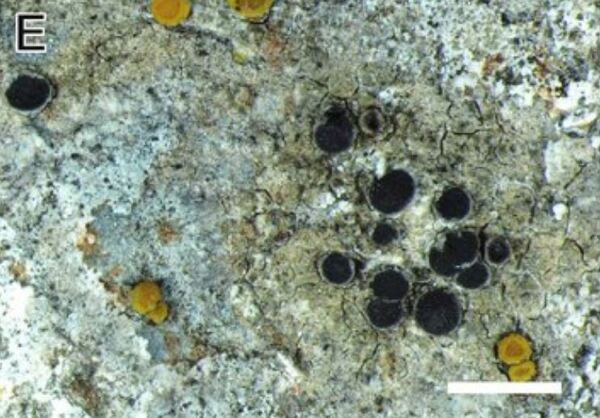Pyrenodesmia microstepposa (Frolov, Nadyeina, Khodos. & Vondrák) Hafellner & Türk
Stapfia, 104, 1: 173, 2016.. Basionym: Caloplaca microstepposa Frolov, Nadyeina, Khodos. & Vondrák - in Frolov & al., Ann. Bot. Fenn, 53: 256, 2016.
Synonyms:
Description: Thallus crustose, episubstratic, areolate, ochre, grey or grey-white, forming small, orbicular, up to c. 1 cm wide, or much larger and irregular patches, the areoles contiguous, angular to round, flat, epruinose, 0.2-0.6 mm wide. Pseudocortex alveolate, often overlain by an epinecral layer; medulla thin, filled with extracellular crystals. Apothecia zeorine or rarely biatorine, 0.3-0.5 mm across, usually adnate, with a brown to black, epruinose disc and a thin margin. Exciple c. 10-90 μm wide, formed of a thalline exciple and a non-amyloid true exciple; uppermost part of true exciple with 2.5-4.5 μm, rarely 2-7 μm wide cells; epithecium brown, rarely brown-grey, K+ brown-violet; hymenium colourless, 75-100 μm high, inspersed with numerous extracellular oil droplets, I+ blue; paraphyses 1.5-2.5(-3) μm thick at mid-level, gradually widening to 3.5-6 μm in upper part; hypothecium colourless, underlain by an algal layer, with extracellular oil droplets, I+ blue; crystals of calcium oxalates absent from all apothecial parts. Asci 8-spored, clavate, functionally unitunicate, apically thickened with a broad internal beak, the inner part of apex and external cap I+ blue, Teloschistes-type. Ascospores 2-celled, polarilocular, hyaline, ellipsoid, 12-21 x 4.5-9.5 μm, the equatorial thickening (“septum”) (1-)1.6-3.5 μm. Pycnidia rare, black, immersed in the thallus. Conidia ellipsoid to broadly ellipsoid. Photobiont chlorococcoid. Spot tests: thallus and apothecia K-, C-, KC-, P-, UV-. Chemistry: no lichen substances in thallus, except traces of the Sedifolia-grey pigment, especially in the upper part of pycnidia.
Growth form: Crustose
Substrata: rocks
Photobiont: green algae other than Trentepohlia
Reproductive strategy: mainly sexual
Subcontinental: restricted to areas with a dry-subcontinental climate (e.g. dry Alpine valleys, parts of Mediterranean Italy)
Commonnes-rarity: (info)
Alpine belt: absent
Subalpine belt: absent
Montane belt: absent
Dry submediterranean belt: very rare
Humid submediterranean belt: absent
Padanian area: absent
pH of the substrata:
1 2 3 4 5
Solar irradiation:
1 2 3 4 5
Aridity:
1 2 3 4 5
Eutrophication:
1 2 3 4 5
Poleotolerance:
0 1 2 3
Altitudinal distribution:
1 2 3 4 5 6
Rarity
absent
extremely rare
very rare
rare
rather rare
rather common
common
very common
extremely common
Loading data...
Occurrence data
Predictive map
Growth form: Crustose
Substrata: rocks
Photobiont: green algae other than Trentepohlia
Reproductive strategy: mainly sexual
Subcontinental: restricted to areas with a dry-subcontinental climate (e.g. dry Alpine valleys, parts of Mediterranean Italy)
Commonnes-rarity: (info)
Alpine belt: absent
Subalpine belt: absent
Montane belt: absent
Dry submediterranean belt: very rare
Humid submediterranean belt: absent
Padanian area: absent
pH of the substrata:
| 1 | 2 | 3 | 4 | 5 |
Solar irradiation:
| 1 | 2 | 3 | 4 | 5 |
Aridity:
| 1 | 2 | 3 | 4 | 5 |
Eutrophication:
| 1 | 2 | 3 | 4 | 5 |
Poleotolerance:
| 0 | 1 | 2 | 3 |
Altitudinal distribution:
| 1 | 2 | 3 | 4 | 5 | 6 |
Rarity
absent
extremely rare
very rare
rare
rather rare
rather common
common
very common
extremely common
Loading data...
Occurrence data
Predictive map







